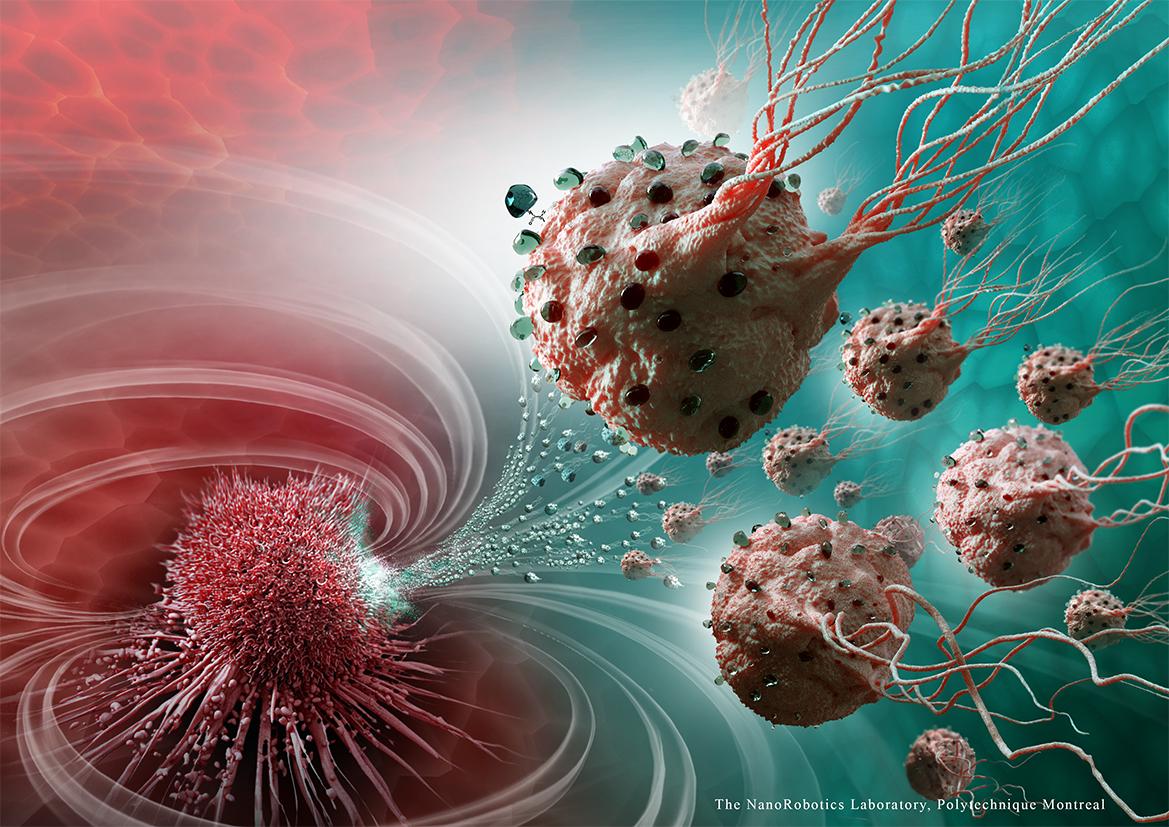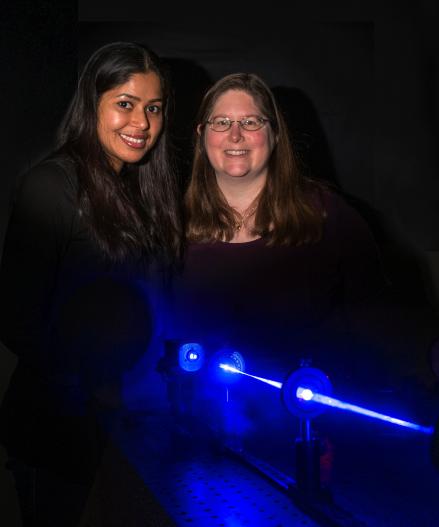
Smart DNA nanorobots that could use logic to diagnose cancer earlier and more accurately than doctors can today; target drugs to tumors, or even manufacture drugs on the spot to cripple cancer
It’s a familiar trope in science fiction: In enemy territory, activate your cloaking device. And real-world viruses use similar tactics to make themselves invisible to the immune system. Now scientists at Harvard’s Wyss Institute for Biologically Inspired Engineering have mimicked these viral tactics to build the first DNA nanodevices that survive the body’s immune defenses.
The results pave the way for smart DNA nanorobots that could use logic to diagnose cancer earlier and more accurately than doctors can today; target drugs to tumors, or even manufacture drugs on the spot to cripple cancer, the researchers report in the April 22 online issue of ACS Nano.
“We’re mimicking virus functionality to eventually build therapeutics that specifically target cells,” said Wyss Institute Core Faculty member William Shih, Ph.D., the paper’s senior author. Shih is also an Associate Professor of Biological Chemistry and Molecular Pharmacology at Harvard Medical School and Associate Professor of Cancer Biology at the Dana-Farber Cancer Institute.
The same cloaking strategy could also be used to make artificial microscopic containers called protocells that could act as biosensors to detect pathogens in food or toxic chemicals in drinking water.
DNA is well known for carrying genetic information, but Shih and other bioengineers are using it instead as a building material. To do this, they use DNA origami — a method Shih helped extend from 2D to 3D. In this method, scientists take a long strand of DNA and program it to fold into specific shapes, much as a single sheet of paper is folded to create various shapes in the traditional Japanese art.
Shih’s team assembles these shapes to build DNA nanoscale devices that might one day be as complex as the molecular machinery found in cells. For example, they are developing methods to build DNA into tiny robots that sense their environment, calculate how to respond, then carry out a useful task, such as performing a chemical reaction or generating mechanical force or movement.
Such DNA nanorobots may themselves sound like science fiction, but they already exist. In 2012 Wyss Institute researchers reported in Science that they had built a nanorobot that uses logic to detect a target cell, then reveals an antibody that activates a “suicide switch” in leukemia or lymphoma cells.
For a DNA nanodevice to successfully diagnose or treat disease, it must survive the body’s defenses long enough to do its job. But Shih’s team discovered that DNA nanodevices injected into the bloodstream of mice are quickly digested.
“That led us to ask, ‘How could we protect our particles from getting chewed up?'” Shih said.
Nature inspired the solution. The scientists designed their nanodevices to mimic a type of virus that protects its genome by enclosing it in a solid protein case, then layering on an oily coating identical to that in membranes that surround living cells. That coating, or envelope, contains a double layer (bilayer) of phospholipid that helps the viruses evade the immune system and delivers them to the cell interior.
“We suspected that a virus-like envelope around our particles could solve our problem,” Shih said.
To coat DNA nanodevices with phospholipid, Steve Perrault, Ph.D., a Wyss Institute Technology Development fellow in Shih’s group and the paper’s lead author, first folded DNA into a virus-sized octahedron. Then, he took advantage of the precision-design capabilities of DNA nanotechnology, building in handles to hang lipids, which in turn directed the assembly of a single bilayer membrane surrounding the octahedron.
Under an electron microscope, the coated nanodevices closely resembled an enveloped virus.
Perrault then demonstrated that the new nanodevices survived in the body. He did that by loading them with fluorescent dye, injecting them into mice, and using whole-body imaging to see what parts of the mouse glowed.
Just the bladder glowed in mice that received uncoated nanodevices, which meant that the animals broke them down quickly and were ready to excrete their contents. But the animals’ entire body glowed for hours when they received the new, coated nanodevices. This showed that nanodevices remained in the bloodstream as long as effective drugs do.
The coated devices also evade the immune system. Levels of two immune-activating molecules were at least 100-fold lower in mice treated with coated nanodevices as opposed to uncoated nanodevices.
In the future, cloaked nanorobots could activate the immune system to fight cancer or suppress the immune system to help transplanted tissue become established.
“Activating the immune response could be useful clinically or it might be something to avoid,” Perrault said. “The main point is that we can control it.”
“Patients with cancer and other diseases would benefit enormously from precise, molecular-scale tools to simultaneously diagnose and treat diseased tissues, and making DNA nanoparticles last in the body is a huge step in that direction,” said Wyss Institute Founding Director Don Ingber, M.D., Ph.D.
The Latest on: Smart DNA nanorobots
[google_news title=”” keyword=”Smart DNA nanorobots” num_posts=”10″ blurb_length=”0″ show_thumb=”left”]
via Google News
The Latest on: Smart DNA nanorobots
- Best DNA Test for 2024on May 15, 2024 at 10:00 am
CNET’s expert staff reviews and rates dozens of new products and services each month, building on more than a quarter century of expertise. If you’ve ever been curious about your genetic ...
- The Best Smart Lockson May 14, 2024 at 11:02 am
When you buy through our links, we may earn a commission. Learn more› By Jon Chase Jon Chase is an editor of smart-home coverage. For Wirecutter, he learned how to pick smart locks and shaved a ...
- The best smart lights in 2024on May 13, 2024 at 2:22 pm
You can add the best smart lights to your home for an extensive level of control and customization over its aesthetic. Connecting these lights to your smart home lets you use your phone or voice ...
- The Best Smart LED Light Bulbs for 2024on May 12, 2024 at 5:00 pm
Why We Picked It Philips makes some of our favorite smart light bulbs, but its Hue LEDs are prciey. Starting at just $9.97, the Philips Dimmable A19 Smart Wi-Fi Wiz Light Bulb is a far more ...
- Nanobots Self Replicateon May 12, 2024 at 5:00 pm
On the other hand, animals — including humans — self-replicate all the time using DNA. Now, scientists are making tiny nanorobots from DNA that can assemble more DNA, including copies of ...
- The Best Smart Air Conditioners for 2024on May 9, 2024 at 4:59 pm
You can control or schedule smart air conditioners from your phone no matter where you are, which means you could save big bucks on energy bills. We've rounded up the top Wi-Fi-connected ACs we've ...
- Smart DNA Expands Operations With New Office in Lekkion April 20, 2024 at 6:28 am
Smart DNA, a leading DNA testing centre in Nigeria, has opened a new office in the Lekki area of Lagos. The new facility aims to serve better the growing demand for DNA testing services in the ...
- Smart DNA takes testing services closer to more Lagos communitieson April 17, 2024 at 5:00 pm
In a bid to make DNA testing services more accessible to more Nigerians, Smart DNA, a leading DNA testing centre in Nigeria, has opened a new office in the Lekki area of Lagos. The new facility ...
- Scientists find new way to desalinate, remove uranium from seawater: Studyon December 21, 2023 at 12:35 pm
Scientists may have found a more efficient water to desalinate water using solar power, according to new research, offering a solution for global water scarcity through the use of renewable energy.
- DNA Nanotechnology: Building Blocks of the Futureon March 26, 2023 at 12:45 pm
See for instance: DNA folds into a smart nanocapsule for drug delivery ... DNA nanotechnology can be used to create nanorobots that are capable of performing specific tasks in the body, such as ...
via Bing News











